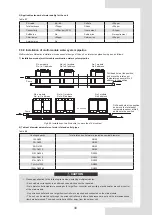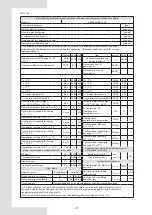
36
11.7 First startup after shutdown
The folowing preparations should be made for re-startup of unit
after long-time shutdown:
1) Thoroughly check and clean unit.
2) Clean water pipe system.
3) Check pump, control valve and other equipments of water pipe
system.
4) Fix connections of all wires.
5) It is a must to electrify the machine 12 hours before starup.
11.8 Refrigeration system
Determine whether refrigerant is needed by checking the
value of suction and discharge pressure and check whether
there is a leakage. Air tight test must be made if there is a
leakage or parts of refrigerating system is to be replaced.
Take different measures in the following two different
conditions from refrigerant injection.
1) Total leakage of refrigerant. In case of such situation,
leakage detection must be made on the pressurized nitrogen
used for the system. If repair welding is needed, welding
cannot be made until all the gas in the system is discharged.
Before injecting refrigerant, the whole refrigeration system
must be completely dry and of vacuum pumping.
Connect vacuum pumping pipe at the fluoride nozzle at low-
pressure side.
Remove air from the system pipe with vacuum pump. The
vacuum pumping lasts for above 3 hours. Confirm that the
indication pressure in dial gauge is within the specified scope.
When the degree of vacuum is reached, inject refrigerant into
the refrigeration system with refrigerant bottle. Appropriate
amount of refrigerant for injection has been indicated on
the nameplate and the table of main technical parameters.
Refrigerant must be injected from the low pressure side of
system.
The injection amount of refrigerant will be affected by the
ambient temperature. If the required amount has not been
reached but no more injection can be done, make the chilled
water circulate and start up the unit for injection. Make the
low pressure switch temporarily short circuit if necessary.
2) Refrigerant supplement. Connect refrigerant injection
bottle on the fluoride nozzle at low-pressure side and connect
pressure gauge at low pressure side.
Make chilled water circulate and start up unit, and make the
low pressure control switch short circuit if necessary.
Slowly inject refrigerant into the system and check suction
and discharge pressure.
CAUTION
• Connection must be renewed after injection
is completed.
• Never inject oxygen, acetylene or other
flammable or poisonous gas to the
refrigeration system at leakage detection
and air tight test. Only pressurized nitrogen
or refrigerant can be used.
11.9 Disassembling compressor
Follow the following procedures if compressor needs to be
disassembled:
1) Cut off the power supply of unit.
2) Remove power source connection wire of compressor.
3) Remove suction and discharge pipes of compressor.
4) Remove fastening screw of compressor.
5) Move the compressor.
11.10 Auxiliary electric heater
When the ambient temperature is lower than 2°C, the
heating efficiency decreases with the decline of the outdoor
temperature. In order to make the air-cooled heat pump
stably run in a relatively cold region and supplement
some heat lost due to de-frosting. When the lowest
ambient temperature in the user’s region in winter is within
0°C~10°C, the user may consider to use auxiliary electric
heater.
Please refer to relevant professionals for the power of
auxiliary electric heater.
11.11 System antifreezing
In case of freezing at the water-side heat exchanger
interval channel, severe damage may be caused, i.e.
heat exchange may be broken and appears leakage. This
damage of frost crack is not within the warranty scope, so
attention must be paid to antifreezing.
1) If the unit that is shutdown for standby is placed in an
environment where the outdoor temperature is lower than
0°C, the water in the water system should be drained.
2) Water pipe may be frozen when the chilled water target
flow controller and anti-freezing temperature senor become
ineffective at running, therefore, the target flow controller
must be connected in accordance with the connection
diagram.
3) Frost crack may happen to water-side heat exchanger
at maintenance when refrigerant is injected to the unit or
is discharged for repair. Pipe freezing is likely to happen
any time when the pressure of refrigerant is below 0.4Mpa.
Therefore, the water in the heat exchanger must be kept
flowing or be thoroughly discharged.
Summary of Contents for KEM-90
Page 52: ......














































